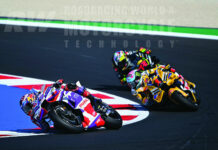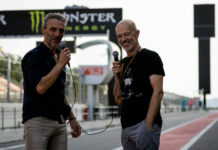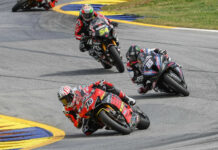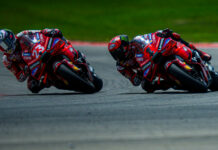From a press release issued by MS Aprilia Racing Press Information:
PREVIEW
Monday 16th September 2002
The Nelson Piquet in Rio ready for 12th round of 2002 World Road Racing Championship
The hottest stage of the 2002 championship is coming up. This week sees the first of four transoceanic transfers: Brazil, in South America and then, one after the other on 6, 13 and 20 October there will be three crucial races: Montegi (Japan), Sentul (Malaysia), and Phillip Island (Australia). The closing curtain will fall on the 2002 season back in Europe, at the last rendezvous in Valencia (Spain) on Sunday 3 November. The Rio circuit, which bears the name of legendary “carioca” of F1, Nelson Piquet, was built in 1975 and started hosting motorcycling competitions two years later. The first international races, however, took place in 1982, a period of glory that was short-lived. The track was often not in ideal shape due to the extreme climate conditions with considerable heat and very high levels of humidity, and this led to the world championship “circus” to stay away for a long time. A full-scale reconstruction project in ‘95 gave the circuit the credentials it needed to become a fixed venue in the World Championship. The track is technical, hard to interpret and, even though entirely resurfaced, there are many uneven parts which are a real challenge for technicians and riders. The Nelson Piquet in Rio also has one of the longest straights in the MotoGP: 1,100 metres of scorching tarmac where engines shift rev counters into the red.
The circuit. Length: 4,933 metres – 8 left corners – 4 right corners – longest straight: 1,100 metres – Maximum width: 18 metres – Constructed in 1975 – Modified in 1995.
2001 winners. 125 Class: Ui (JAP) Derbi – Class, 250 Class: Kato (Jap) Honda – 500 Class: Rossi (Ita) Honda.
Circuit records – 125: 1’59.368, Giansanti 2000 – 250: 1’54.230, Rossi, 1999 – 500: 1’51.928, Okada, 1997.
APRILIA LEADING IN 4 CHAMPIONSHIPS
After 11 rounds out of 16 in the 2002 MotoGP, Aprilia tops the charts in 4 out of the 6 championships:
1st in the 250 class riders’ championship with Marco Melandri
1st in the 125 class riders’ championship with Arnaud Vincent
1st in the 250 class manufacturers’ championship
1st in the 125 class manufacturers’ championship
125 CLASS
In the 125 class, after his brilliant victory at Estoril, Arnaud Vincent (Aprilia – 194 points) has reached top spot in the ratings and now has a 23 point lead over his closest rival, Poggiali (Gilera – 171 points). Aprilia leads the way in the manufacturers’ championship with 240 points, 57 ahead of Honda (183).
250 CLASS
In the 250cc at Estoril, Marco Melandri (Aprilia) came second to his closest rival, Aprilia-mounted Fonsi Nieto, losing a little bit of ground in his advantage over the current runner-up: 5 points. The young lion from Ravenna still has a 32 point lead to play around with. Aprilia, firmly at the top of the tables in the manufacturers’ championship, has a 107 point lead over the Japanese “winged” bikes. If the riders are on a winning streak, Aprilia could (the conditional is obligatory here) win the title in Brazil if it manages to get one point more than the 100 still remaining to be assigned in the next four races of the 2002 season.
MARCO MELANDRI – 250cc Class – Aprilia RSW 250
In the words of Macio, a brief analysis of the “tactical” race in the rain at Estoril and a comment on the Brazilian track that is to host the twelfth round of the 2002 World Championhip this week.
“Now that Estoril – a tough, long and difficult race – is over, we’ve come to the key stage in the championship. I’d like to spend a few more words on the recent race at Estoril, as it‘s so important to take stock of the situation before we get caught up in the final rush. We were prepared for a race on a dry track, but Sunday’s downpour changed everything completely. Difficult conditions in which it would have been easy to lose the entire advantage I’d gained up to that point with just a single mistake. But we were able to keep damage under control and, in the end, we came out of it with colours flying. So we’re now on to round 12, but motivation is as strong as ever, and the objective the same: to go for victory as soon as those green lights come on. Working for victory, more than anything: if the conditions are right, the best possible result of the championship will come by itself. I like the Rio circuit: it’s full of bumps and holes so the settings on the bike are going to be crucial. We’ll need to find a set-up that makes the right compromise: the bike needs to be soft enough to absorb the unevenness of the track, but it’s also got to be able to take the corners properly. The choice of tyres shouldn’t be a problem, and the weather shouldn’t be quite as hot as in the past. For the previous two years, Rio was the last or penultimate race of the championship, but now it’s been moved forward a bit so it’ll be somewhat cooler. In any case, I’m just hoping we get fine weather – I sure don’t want a repeat of Estoril. Rio could be the opportunity for Aprilia to win the 2002 manufacturers’ title in the 250 class: I’d like to be able to win, and “hand over” the title to Aprilia myself.”
REGIS LACONI – MotoGP – Aprilia RS3
“Rio’s a track I like. Technical, tough and with holes all over the place. The two parallel straights are great: when you’re riding on the home stretch, you can actually look across and see the other straight. This is where you can let the engine open right up and, with the Cube, we’ll be there to do our bit. Apart from that, Rio is a sequence of bends, of which three are very fast. Like the slow corners, these too are followed by rapid acceleration. I’m highly motivated: the Cube’s made enormous progress since the Mugello tests. We’ve found a new line of approach and development work’s really taken off again. I’m very pleased and I can see the whole group’s really satisfied with some of the new solutions. The bike’s shorter now and the wheelbase has been reduced: the first time round it seemed more difficult to ride, but once I got the idea, it proved to be fantastic. I’ve got a good feeling again with greater grip at the rear, and the bike’s much easier to handle. This is highly motivating and the results first came during the race in the downpour at Estoril. The Cube was performing really well and I’m not too bad in the wet so when I was in eighth place I was keeping up the same pace as the others: I wasn’t going to give in and, in spite of all the water, I was riding to beat them. I wanted to do well. Unfortunately, a slide dashed my hopes but it was only natural and right that I should have been going for a good result. Now we’re going to Rio, where the weather should be rather like late spring in Europe, and with this latest step – which I really like – in the Cube’s development, we really want to get a good result.”
More, from a press release issued by Michelin:
ROSSI & MICHELIN CAN CLAIM MotoGP CROWN AT RIO
Valentino Rossi (Repsol Honda Team RC211V-Michelin) could wrap up the first-ever MotoGP World Championship at Rio this weekend. And if the hugely popular Italian does secure the title here he will give Michelin its 11th successive premier-class championship success and its 22nd in the past 27 years. All Rossi has to do on Saturday is win his tenth victory of 2002, with Tohru Ukawa (Repsol Honda Team RC211V-Michelin) lower than third, though the Japanese has recently developed a liking for third-place, filling the final podium place at the last three GPs! The HRC team-mates are the only title contenders, though Michelin’s MotoGP presence has massive strength in depth with Michelin riders holding the top nine places in the series.
Michelin has totally dominated the first season of MotoGP racing, taking race victory, pole position and fastest lap at all 11 rounds so far, as well as filling 32 of the 33 podium positions at those 11 races. The French company’s Grand Prix engineers have been working harder than ever during 2002, developing the S4 rear slick, designed to harness the 200-plus horsepower outputs of the new four-strokes, and lately focusing on a new front slick, an important step forward in the never-ending search for extra grip and feel. Michelin’s unceasing effort has paid the company handsome dividends – the French tyres have won all but one of the last 104 premier-class GPs, including an ongoing run of 65 successive wins.
Now the masters of motorcycle tyre performance must add logistical brilliance to their technical genius, working closely with their air-freight carriers to ensure their riders have exactly the tyres they want at the year’s final five GPs. Over the next six weeks riders and teams travel from Brazil to Japan, Malaysia and Australia, before returning to Europe for the season-ending Valencia Grand Prix on November 3. This quick-fire run of races will test everyone to the limit – riders, teams, factories and the sport’s major technical partners like Michelin who face the massively complex task of delivering 2000 of their latest tyres to each and every one of these five events dotted around the globe.
MICHELIN RIDER ALEX BARROS AND JACAREPAGUA
Local hero Alex Barros (West Honda Pons NSR500-Michelin) will be throwing everything into winning Saturday’s Rio GP. The man from Sao Paulo has yet to win his home race, and he knows this won’t be an easy weekend for him because the Jacarepagua track is likely to favour the more powerful four-strokes machines over his 500 two-stroke. The fast, open circuit which features one of GP racing’s longest straights should allow the four-strokes to exploit their horsepower advantage. But Barros will be giving it his all in what will be one of his final races on a two-stroke.
“It will be another difficult race for us, because Rio is a fast track,” says Barros, winner of four 500 GPs, all with Michelin. “The four-strokes are much faster than the 500s in a straight line, there’s no way we can even hold their slipstream, so they’ll have a big advantage down the main straight. I think we can be faster through the curves, I know I’m really quick through the final section of the circuit, and I know I’m very strong on the brakes, which is useful at the end of the big straight. But it’s a case of weighing up the time we gain and the time we lose, and overall the four-strokes will be faster. The only time we really have an advantage is on Friday, when the four-strokes are starting from zero on set-up, because this is their first time at the track.”
Despite his nationality, Barros has no home-track advantage at Jacarepagua, because he races here no more often than his MotoGP rivals. Nonetheless he’s got the track well worked out, as he proved two years ago when he was a close second-place finisher to Valentino Rossi (Nastro Azzurro Honda NSR500-Michelin). Barros reckons that the front tyre is particularly crucial at Rio, because the track is bumpy and not too grippy, so the front end is constantly loading up and unloading. Feel, therefore, is everything.
“You use a lot of front tyre at Rio, just because of the bumps and the style of the track,” he adds. “So you really need to work on the front end of the bike, you need the machine set-up to work really well with the tyre, otherwise you won’t have enough grip or endurance. I’ve been using a new-construction Michelin front since Germany. The tyre gives better turn in, so you can get into the corners a little faster, and it also offers more feel, which is good for your confidence.”
Of course, rear grip is always a major concern, but Barros has as much rear-end traction as he can handle right now, thanks to advances from Michelin’s S4 rear slick, which was originally developed for the four-strokes.
“We have a lot more rear grip from the S4 this year, which has allowed us to go much faster than before,” he explains. “But the problem is that this extra grip also helps the four-strokes use more of their power advantage earlier in the corner, which isn’t good for us 500 riders! During the races there doesn’t seem to be a huge difference in the way the two types of machine use their tyres. The four-strokes have softer power delivery, which is good for their tyres, but they have more power and weight, so I think it evens out. Usually we can use slightly softer tyres but I don’t think either type of bike has a rubber advantage in the later stages of races.
“I’m really looking forward to Rio this year. The race didn’t use to be so big but over the last two years the crowd has really grown, which is great for me. They make a lot of noise – they’re Brazilians – which makes a real difference, I can really feel their support!”
MICHELIN TYRES AND JACAREPAGUA
Michelin has won nine of the ten GPs staged in Brazil (hosted at three different tracks – Goiania, Interlagos and Jacarepagua) and is looking to continue its total domination of bike racing’s premier class this weekend. The Jacarepagua track is another real challenge for riders and engineers, and another chance for Michelin to learn more about its latest front and rear slicks.
The 16.5in S4 rear slick was the big news at the start of the 2002 season, contributing to another leap forward in performance, just over a year since the company’s 16.5in rear revolutionised the 500 class. In more recent weeks Michelin has upped the ante still further with a new front slick, which has rapidly gained favour with most of Michelin’s 13 MotoGP riders.
“We believe that our new front will be particularly good for Rio, because it offers a lot of feedback,” says Michelin Grand Prix manager Emmanuel Fournier. “It’s something in the construction of this new tyre that gives more feeling but we can’t say what! The front construction we use at Rio is stronger, but that doesn’t mean harder, it’s more complicated than that. A less strong construction can absorb too much, so it behaves like a filter between the track and the bike, so the rider doesn’t receive such accurate feedback. And feedback and feeling are vital if a rider is to be able to fully exploit all the available traction.
“We’ve been testing several different compounds with this new front and we have one in particular that has worked well at all the last few circuits. This is important for us, and for our riders, because we always like to have one front compound that works for everyone at pretty much every track. Riders like to be very familiar with the front tyre, so it’s very useful for them if they have one tyre they can count on, whatever kind of problem they’re having.
“Rio can be slippery but only when the surface is dirty. When the circuit is clean the grip level is fairly normal, certainly enough for us to work correctly. We’ll have to see how grippy it is on Thursday. The surface will get cleaner with use, the only worry is that it can sometimes take more than the weekend to be fully clean!”
This year is a particularly unusual year for the premier Grand Prix class, with 990cc four-strokes racing against 500cc two-strokes. And although the S4 rear has been successfully used by both types of machine, Michelin is now producing different types of S4.
“It seems that we’re now taking slightly different directions in developing the S4 rear for the two-strokes and four-strokes,” adds Fournier. “At the beginning of the season riders of both types of machine were using pretty much the same S4 but we knew that we’d take different directions as the season developed. Now we have some choices that work well with both types of bike, one that is designed to work more for the four-strokes and another for the two-strokes. The four-stroke S4 uses a stronger compound from what we learned at Brno in August.
“We are still happy to develop an S4 tyre for the two-strokes because we want them to have the best-possible chance of winning. They can run a softer tyre, which can give them an advantage in the early stages of a race, so long as they work to look after it for the final laps.”
The pace of MotoGP tyre development has forced Michelin to undertake more radical logistics than ever before during the traditional run of late-season out-of-Europe GPs. “We are sending more tyres by plane than ever before, because the pace of development is so fast,” reveals Fournier, who organises 2000 tyres for each GP. “In the past we sent some tyres by sea, but we would need to despatch these tyres six weeks before each race, which is just too early now, considering the pace of development. This year more tyres are going by plane, some flown from one race to the next, and other directly from France. It means a very tight schedule for us.”
JACAREPAGUA DATA
Lap record
Tadayuki Okada (Repsol Honda NSR500-Michelin)
1m 51.928s 158.662kmh/98.588mph (1997)
More Rio MotoGP Previews
More Rio MotoGP Previews
© 2002, Roadracing World Publishing, Inc.






